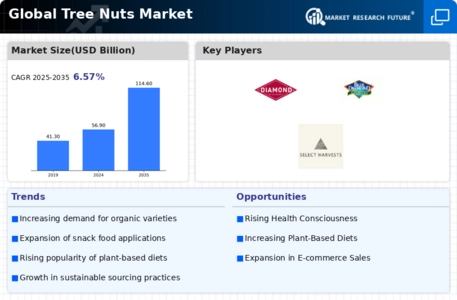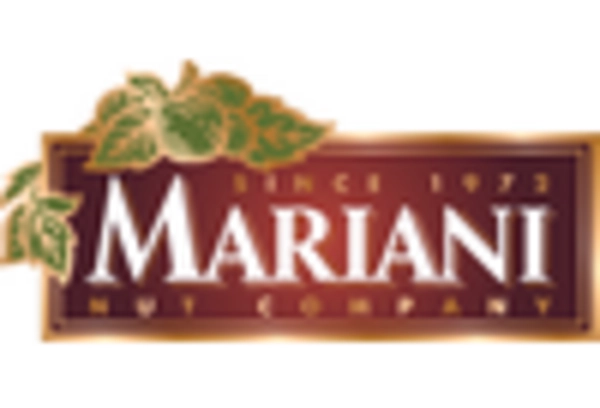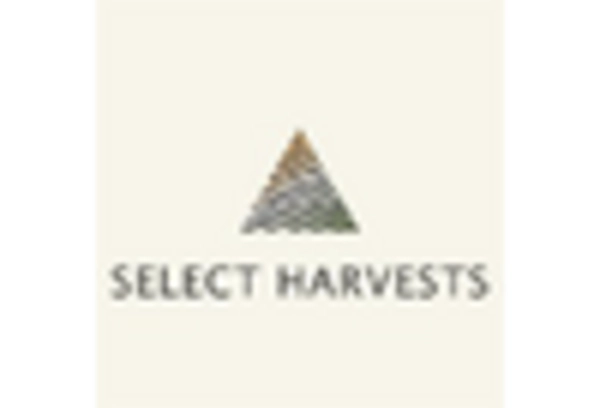-
EXECUTIVE SUMMARY 16
-
MARKET ATTRACTIVENESS ANALYSIS 17
- GLOBAL TREE NUTS MARKET, BY PRODUCT TYPE 18
- GLOBAL TREE NUTS MARKET, FORM 19
- GLOBAL TREE NUTS MARKET, APPLICATION 20
- GLOBAL TREE NUTS MARKET, DISTRIBUTION CHANNEL 21
- GLOBAL TREE NUTS MARKET, BY REGION 22
-
MARKET INTRODUCTION 23
-
DEFINITION 23
-
SCOPE OF THE STUDY 23
-
RESEARCH OBJECTIVE 23
-
MARKET STRUCTURE 24
-
KEY BUYING CRITERIA 24
-
RESEARCH METHODOLOGY 25
-
RESEARCH PROCESS 25
-
PRIMARY RESEARCH 26
-
SECONDARY RESEARCH 27
-
MARKET SIZE ESTIMATION 28
-
FORECAST MODEL 29
-
LIST OF ASSUMPTIONS & LIMITATIONS 30
-
MARKET DYNAMICS 31
-
INTRODUCTION 31
-
DRIVERS 32
- CONSUMER PREFERENCE FOR HIGHLY NUTRITIVE NUT SNACKS 32
- WIDESPREAD APPLICATION IN VARIOUS INDUSTRIES 33
- DRIVERS IMPACT ANALYSIS 33
-
RESTRAINT 34
- RISING PREVALENCE OF NUT ALLERGIES 34
- RESTRAINT IMPACT ANALYSIS 34
-
OPPORTUNITY 35
- GROWING VEGAN POPULATION 35
- RISING AWARENESS OF BY-PRODUCTS 35
-
-
MARKET FACTOR ANALYSIS 36
-
VALUE CHAIN ANALYSIS 36
-
SUPPLY CHAIN ANALYSIS 38
-
PORTER’S FIVE FORCES MODEL 39
- THREAT OF NEW ENTRANTS 39
- BARGAINING POWER OF SUPPLIERS 40
- BARGAINING POWER OF BUYERS 40
- THREAT OF SUBSTITUTES 40
- INTENSITY OF RIVALRY 40
-
IMPACT OF COVID-19 PANDEMIC ON THE GLOBAL TREE NUTS MARKET 41
-
IMPACT ON PRODUCTION 41
- IMPACT ON SUPPLY CHAIN 41
- IMPACT ON PRICING 42
- IMPACT ON END-USE APPLICATION AREAS 42
-
GLOBAL TREE NUTS MARKET, BY PRODUCT TYPE 43
-
OVERVIEW 43
- GLOBAL TREE NUTS MARKET ESTIMATES & FORECAST, BY PRODUCT TYPE, 2024-2032 44
-
CASHEW NUTS 44
- CASHEW NUTS: MARKET ESTIMATES & FORECAST, BY REGION, 2024-2032 44
-
WALNUTS 45
- WALNUTS: MARKET ESTIMATES & FORECAST, BY REGION, 2024-2032 45
-
ALMONDS 45
- ALMONDS: MARKET ESTIMATES & FORECAST, BY REGION, 2024-2032 45
-
PISTACHIOS 46
- PISTACHIOS: MARKET ESTIMATES & FORECAST, BY REGION, 2024-2032 46
-
HAZELNUTS 46
- HAZELNUTS: MARKET ESTIMATES & FORECAST, BY REGION, 2024-2032 46
-
CHESTNUTS 47
- CHESTNUTS: MARKET ESTIMATES & FORECAST, BY REGION, 2024-2032 47
-
BRAZILNUTS 47
- BRAZILNUTS: MARKET ESTIMATES & FORECAST, BY REGION, 2024-2032 47
-
MACADAMIA NUTS 48
- MACADAMIA NUTS: MARKET ESTIMATES & FORECAST, BY REGION, 2024-2032 48
-
OTHERS 48
- OTHERS: MARKET ESTIMATES & FORECAST, BY REGION, 2024-2032 48
-
-
GLOBAL TREE NUTS MARKET, BY FORM 50
-
OVERVIEW 50
- GLOBAL TREE NUTS MARKET ESTIMATES & FORECAST, BY FORM, 2024-2032 51
-
WHOLE 51
- WHOLE: MARKET ESTIMATES & FORECAST, BY REGION, 2024-2032 51
-
SPLITS 52
- SPLITS: MARKET ESTIMATES & FORECAST, BY REGION, 2024-2032 52
-
OTHERS 52
- OTHERS: MARKET ESTIMATES & FORECAST, BY REGION, 2024-2032 52
-
GLOBAL TREE NUTS MARKET, BY APPLICATION 53
-
OVERVIEW 53
- GLOBAL TREE NUTS MARKET ESTIMATES & FORECAST, BY APPLICATION, 2024-2032 54
-
DIRECT CONSUMPTION/CULINARY PURPOSE 54
- DIRECT CONSUMPTION/CULINARY PURPOSE: MARKET ESTIMATES & FORECAST, BY REGION, 2024-2032 54
-
BAKERY & CONFECTIONERY 55
- BAKERY & CONFECTIONERY: MARKET ESTIMATES & FORECAST, BY REGION, 2024-2032 55
-
BREAKFAST CEREALS 55
- BREAKFAST CEREALS: MARKET ESTIMATES & FORECAST, BY REGION, 2024-2032 55
-
SNACKS 56
- SNACKS: MARKET ESTIMATES & FORECAST, BY REGION, 2024-2032 56
-
FLAVORED DRINKS 56
- FLAVORED DRINKS: MARKET ESTIMATES & FORECAST, BY REGION, 2024-2032 56
-
BUTTER & SPREADS 57
- BUTTER & SPREADS: MARKET ESTIMATES & FORECAST, BY REGION, 2024-2032 57
-
DAIRY PRODUCTS 57
- DAIRY PRODUCTS: MARKET ESTIMATES & FORECAST, BY REGION, 2024-2032 57
-
OTHERS 58
- OTHERS: MARKET ESTIMATES & FORECAST, BY REGION, 2024-2032 58
-
GLOBAL TREE NUTS MARKET, BY DISTRIBUTION CHANNEL 59
-
OVERVIEW 59
- GLOBAL TREE NUTS MARKET ESTIMATES & FORECAST, BY DISTRIBUTION CHANNEL, 2024-2032 60
-
B2B 60
- B2B: MARKET ESTIMATES & FORECAST, BY REGION, 2024-2032 60
-
B2C 60
- B2C: MARKET ESTIMATES & FORECAST, BY REGION, 2024-2032 61
-
-
GLOBAL TREE NUTS MARKET, BY REGION 62
-
OVERVIEW 62
-
NORTH AMERICA 64
- US 67
- CANADA 69
- MEXICO 71
-
EUROPE 73
- UK 76
- GERMANY 78
- FRANCE 80
- ITALY 82
- SPAIN 84
- REST OF EUROPE 86
-
ASIA-PACIFIC 88
- CHINA 91
- INDIA 93
- JAPAN 95
- AUSTRALIA & NEW ZEALAND 97
- REST OF ASIA-PACIFIC 99
-
REST OF THE WORLD 101
- SOUTH AMERICA 104
- MIDDLE EAST 106
- AFRICA 108
-
COMPETITIVE LANDSCAPE 110
-
INTRODUCTION 110
- MARKET STRATEGY ANALYSIS 110
-
COMPETITIVE BENCHMARKING 111
-
KEY DEVELOPMENTS & GROWTH STRATEGIES 112
- ACQUISITION 112
- EXPANSION 112
- DEVELOPMENT 112
-
COMPANY PROFILES 113
-
OLAM INTERNATIONAL LTD. 113
- COMPANY OVERVIEW 113
- FINANCIAL OVERVIEW 114
- PRODUCTS OFFERED 114
- KEY DEVELOPMENTS 115
- SWOT ANALYSIS 116
- KEY STRATEGIES 116
-
DIAMOND FOOD 117
- COMPANY OVERVIEW 117
- FINANCIAL OVERVIEW 117
- PRODUCTS OFFERED 117
- KEY DEVELOPMENTS 118
- SWOT ANALYSIS 118
- KEY STRATEGIES 118
-
MARIANI NUT COMPANY LLC 119
- COMPANY OVERVIEW 119
- FINANCIAL OVERVIEW 119
- PRODUCTS OFFERED 119
- KEY DEVELOPMENTS 120
- SWOT ANALYSIS 120
- KEY STRATEGIES 120
-
BLUE DIAMOND GROWERS 121
- COMPANY OVERVIEW 121
- FINANCIAL OVERVIEW 121
- PRODUCTS OFFERED 121
- KEY DEVELOPMENTS 122
- SWOT ANALYSIS 122
- KEY STRATEGIES 122
-
SELECT HARVESTS LTD. 123
- COMPANY OVERVIEW 123
- FINANCIAL OVERVIEW 123
- PRODUCTS OFFERED 123
- KEY DEVELOPMENTS 124
- SWOT ANALYSIS 124
- KEY STRATEGIES 125
-
WATERFORD NUT COMPANY INC. 126
- COMPANY OVERVIEW 126
- FINANCIAL OVERVIEW 126
- PRODUCTS OFFERED 126
- KEY DEVELOPMENTS 127
- SWOT ANALYSIS 127
- KEY STRATEGIES 127
-
-
ARCHER DANIELS MIDLAND COMPANY 128
- COMPANY OVERVIEW 128
- FINANCIAL OVERVIEW 129
- PRODUCTS OFFERED 129
- KEY DEVELOPMENTS 130
- SWOT ANALYSIS 131
- KEY STRATEGIES 131
-
TREE NUTS INTERNATIONAL 132
- COMPANY OVERVIEW 132
- FINANCIAL COMPANY OVERVIEW 132
- PRODUCTS OFFERED 132
- KEY DEVELOPMENTS 132
- SWOT ANALYSIS 133
- KEY STRATEGIES 133
-
LONE TREE NUT COMPANY 134
- COMPANY OVERVIEW 134
- FINANCIAL OVERVIEW 134
- PRODUCTS OFFERED 134
- KEY DEVELOPMENTS 135
- SWOT ANALYSIS 135
- KEY STRATEGIES 136
-
SUN VALLEY NUT, LLC 137
- COMPANY OVERVIEW 137
- FINANCIAL OVERVIEW 137
- KEY DEVELOPMENTS 137
- SWOT ANALYSIS 138
- KEY STRATEGY 138
-
APPENDIX 139
-
REFERENCES 139
-
RELATED REPORTS 139
-
-
LIST OF TABLES
-
PRIMARY INTERVIEWS 26
-
LIST OF ASSUMPTIONS & LIMITATIONS 30
-
NUTRITION CONTENT OF TREE NUTS (G/1 OZ) 32
-
GLOBAL TREE NUTS MARKET ESTIMATES & FORECAST, BY PRODUCT TYPE, 2024-2032 (USD MILLION) 44
-
CASHEW NUTS: MARKET ESTIMATES & FORECAST, BY REGION, 2024-2032 (USD MILLION) 44
-
WALNUTS: MARKET ESTIMATES & FORECAST, BY REGION, 2024-2032 (USD MILLION) 45
-
ALMONDS: MARKET ESTIMATES & FORECAST, BY REGION, 2024-2032 (USD MILLION) 45
-
PISTACHIOS: MARKET ESTIMATES & FORECAST, BY REGION, 2024-2032 (USD MILLION) 46
-
HAZELNUTS: MARKET ESTIMATES & FORECAST, BY REGION, 2024-2032 (USD MILLION) 46
-
CHESTNUTS: MARKET ESTIMATES & FORECAST, BY REGION, 2024-2032 (USD MILLION) 47
-
BRAZILNUTS: MARKET ESTIMATES & FORECAST, BY REGION, 2024-2032 (USD MILLION) 47
-
MACADAMIA NUTS: MARKET ESTIMATES & FORECAST, BY REGION, 2024-2032 (USD MILLION) 48
-
OTHERS: MARKET ESTIMATES & FORECAST, BY REGION, 2024-2032 (USD MILLION) 48
-
GLOBAL TREE NUTS MARKET ESTIMATES & FORECAST, BY FORM, 2024-2032 (USD MILLION) 51
-
WHOLE: MARKET ESTIMATES & FORECAST, BY REGION, 2024-2032 (USD MILLION) 51
-
SPLITS: MARKET ESTIMATES & FORECAST, BY REGION, 2024-2032 (USD MILLION) 52
-
OTHERS: MARKET ESTIMATES & FORECAST, BY REGION, 2024-2032 (USD MILLION) 52
-
GLOBAL TREE NUTS MARKET ESTIMATES & FORECAST, BY APPLICATION, 2024-2032 (USD MILLION) 54
-
DIRECT CONSUMPTION/CULINARY PURPOSE: MARKET ESTIMATES & FORECAST, BY REGION, 2024-2032 (USD MILLION) 54
-
BAKERY & CONFECTIONERY: MARKET ESTIMATES & FORECAST, BY REGION, 2024-2032 (USD MILLION) 55
-
BREAKFAST CEREALS: MARKET ESTIMATES & FORECAST, BY REGION, 2024-2032 (USD MILLION) 55
-
SNACKS: MARKET ESTIMATES & FORECAST, BY REGION, 2024-2032 (USD MILLION) 56
-
FLAVORED DRINKS: MARKET ESTIMATES & FORECAST, BY REGION, 2024-2032 (USD MILLION) 56
-
BUTTER & SPREADS: MARKET ESTIMATES & FORECAST, BY REGION, 2024-2032 (USD MILLION) 57
-
DAIRY PRODUCTS: MARKET ESTIMATES & FORECAST, BY REGION, 2024-2032 (USD MILLION) 57
-
OTHERS: MARKET ESTIMATES & FORECAST, BY REGION, 2024-2032 (USD MILLION) 58
-
GLOBAL TREE NUTS MARKET ESTIMATES & FORECAST, BY DISTRIBUTION CHANNEL, 2024-2032 (USD MILLION) 60
-
B2B: MARKET ESTIMATES & FORECAST, BY REGION, 2024-2032 (USD MILLION) 60
-
B2C: MARKET ESTIMATES & FORECAST, BY REGION, 2024-2032 (USD MILLION) 61
-
GLOBAL TREE NUTS MARKET ESTIMATES & FORECAST, BY REGION, 2024-2032 (USD MILLION) 63
-
NORTH AMERICA: TREE NUTS MARKET ESTIMATES & FORECAST, BY COUNTRY, 2024-2032 (USD MILLION) 64
-
NORTH AMERICA: TREE NUTS MARKET, BY PRODUCT TYPE, 2024-2032 (USD MILLION) 65
-
NORTH AMERICA: TREE NUTS MARKET, BY FORM, 2024-2032 (USD MILLION) 65
-
NORTH AMERICA: TREE NUTS MARKET, BY APPLICATION, 2024-2032 (USD MILLION) 66
-
NORTH AMERICA: TREE NUTS MARKET, BY DISTRIBUTION CHANNEL, 2024-2032 (USD MILLION) 66
-
US: TREE NUTS MARKET, BY PRODUCT TYPE, 2024-2032 (USD MILLION) 67
-
US: TREE NUTS MARKET, BY FORM, 2024-2032 (USD MILLION) 67
-
US: TREE NUTS MARKET, BY APPLICATION, 2024-2032 (USD MILLION) 68
-
U.S: TREE NUTS MARKET, BY DISTRIBUTION CHANNEL, 2024-2032 (USD MILLION) 68
-
CANADA: TREE NUTS MARKET, BY PRODUCT TYPE, 2024-2032 (USD MILLION) 69
-
CANADA: TREE NUTS MARKET, BY FORM, 2024-2032 (USD MILLION) 69
-
CANADA: TREE NUTS MARKET, BY APPLICATION, 2024-2032 (USD MILLION) 70
-
CANADA: TREE NUTS MARKET, BY DISTRIBUTION CHANNEL, 2024-2032 (USD MILLION) 70
-
MEXICO: TREE NUTS MARKET, BY PRODUCT TYPE, 2024-2032 (USD MILLION) 71
-
MEXICO: TREE NUTS MARKET, BY FORM, 2024-2032 (USD MILLION) 71
-
MEXICO: TREE NUTS MARKET, BY APPLICATION, 2024-2032 (USD MILLION) 72
-
MEXICO: TREE NUTS MARKET, BY DISTRIBUTION CHANNEL, 2024-2032 (USD MILLION) 72
-
EUROPE: TREE NUTS MARKET ESTIMATES & FORECAST, BY COUNTRY, 2024-2032 (USD MILLION) 73
-
EUROPE: TREE NUTS MARKET, BY PRODUCT TYPE, 2024-2032 (USD MILLION) 74
-
EUROPE: TREE NUTS MARKET, BY FORM, 2024-2032 (USD MILLION) 74
-
EUROPE: TREE NUTS MARKET, BY APPLICATION, 2024-2032 (USD MILLION) 75
-
EUROPE: TREE NUTS MARKET, BY DISTRIBUTION CHANNEL, 2024-2032 (USD MILLION) 75
-
UK: TREE NUTS MARKET, BY PRODUCT TYPE, 2024-2032 (USD MILLION) 76
-
UK: TREE NUTS MARKET, BY FORM, 2024-2032 (USD MILLION) 76
-
UK: TREE NUTS MARKET, BY APPLICATION, 2024-2032 (USD MILLION) 77
-
UK: TREE NUTS MARKET, BY DISTRIBUTION CHANNEL, 2024-2032 (USD MILLION) 77
-
GERMANY: TREE NUTS MARKET, BY PRODUCT TYPE, 2024-2032 (USD MILLION) 78
-
GERMANY: TREE NUTS MARKET, BY FORM, 2024-2032 (USD MILLION) 78
-
GERMANY: TREE NUTS MARKET, BY APPLICATION, 2024-2032 (USD MILLION) 79
-
GERMANY: TREE NUTS MARKET, BY DISTRIBUTION CHANNEL, 2024-2032 (USD MILLION) 79
-
FRANCE: TREE NUTS MARKET, BY PRODUCT TYPE, 2024-2032 (USD MILLION) 80
-
FRANCE: TREE NUTS MARKET, BY FORM, 2024-2032 (USD MILLION) 80
-
FRANCE: TREE NUTS MARKET, BY APPLICATION, 2024-2032 (USD MILLION) 81
-
FRANCE: TREE NUTS MARKET, BY DISTRIBUTION CHANNEL, 2024-2032 (USD MILLION) 81
-
ITALY: TREE NUTS MARKET, BY PRODUCT TYPE, 2024-2032 (USD MILLION) 82
-
ITALY: TREE NUTS MARKET, BY FORM, 2024-2032 (USD MILLION) 82
-
ITALY: TREE NUTS MARKET, BY APPLICATION, 2024-2032 (USD MILLION) 83
-
ITALY: TREE NUTS MARKET, BY DISTRIBUTION CHANNEL, 2024-2032 (USD MILLION) 83
-
SPAIN: TREE NUTS MARKET, BY PRODUCT TYPE, 2024-2032 (USD MILLION) 84
-
SPAIN: TREE NUTS MARKET, BY FORM, 2024-2032 (USD MILLION) 84
-
SPAIN: TREE NUTS MARKET, BY APPLICATION, 2024-2032 (USD MILLION) 85
-
SPAIN: TREE NUTS MARKET, BY DISTRIBUTION CHANNEL, 2024-2032 (USD MILLION) 85
-
- Cashew Nuts
- Walnuts
- Almonds
- Pistachios
- Hazelnuts
- Chestnuts
- Brazil Nuts
- Macadamia Nuts
- Others
- Direct Consumption/Culinary Purpose
- Bakery & Confectionery
- Breakfast Cereals
- Snacks
- Flavored Drinks
- Butter & Spreads
- Dairy Products
- Others
- North America Outlook (USD Million, 2022-2030)
- North America Tree Nuts by Product Type
- Cashew Nuts
- Walnuts
- Almonds
- Pistachios
- Hazelnuts
- Chestnuts
- Brazil Nuts
- Macadamia Nuts
- Others
- North America Tree Nuts by Form
- North America Tree Nuts by Application
- Direct Consumption/Culinary Purpose
- Bakery & Confectionery
- Breakfast Cereals
- Snacks
- Flavored Drinks
- Butter & Spreads
- Dairy Products
- Others
- North America Tree Nuts by Distribution Channel
- US Outlook (USD Million, 2022-2030)
- US Tree Nuts by Product Type
- Cashew Nuts
- Walnuts
- Almonds
- Pistachios
- Hazelnuts
- Chestnuts
- Brazil Nuts
- Macadamia Nuts
- Others
- US Tree Nuts by Form
- US Tree Nuts by Application
- Direct Consumption/Culinary Purpose
- Bakery & Confectionery
- Breakfast Cereals
- Snacks
- Flavored Drinks
- Butter & Spreads
- Dairy Products
- Others
- US Tree Nuts by Distribution Channel
- CANADA Outlook (USD Million, 2022-2030)
- Canada Tree Nuts by Product Type
- Cashew Nuts
- Walnuts
- Almonds
- Pistachios
- Hazelnuts
- Chestnuts
- Brazil Nuts
- Macadamia Nuts
- Others
- Canada Tree Nuts by Form
- Canada Tree Nuts by Application
- Direct Consumption/Culinary Purpose
- Bakery & Confectionery
- Breakfast Cereals
- Snacks
- Flavored Drinks
- Butter & Spreads
- Dairy Products
- Others
- Canada Tree Nuts by Distribution Channel
- Mexico Outlook (USD Million, 2022-2030)
- Mexico Tree Nuts by Product Type
- Cashew Nuts
- Walnuts
- Almonds
- Pistachios
- Hazelnuts
- Chestnuts
- Brazil Nuts
- Macadamia Nuts
- Others
- Mexico Tree Nuts by Form
- Mexico Tree Nuts by Application
- Direct Consumption/Culinary Purpose
- Bakery & Confectionery
- Breakfast Cereals
- Snacks
- Flavored Drinks
- Butter & Spreads
- Dairy Products
- Others
- Mexico Tree Nuts by Distribution Channel
- Europe Outlook (USD Million, 2022-2030)
- Europe Tree Nuts by Product Type
- Cashew Nuts
- Walnuts
- Almonds
- Pistachios
- Hazelnuts
- Chestnuts
- Brazil Nuts
- Macadamia Nuts
- Others
- Europe Tree Nuts by Form
- Europe Tree Nuts by Application
- Direct Consumption/Culinary Purpose
- Bakery & Confectionery
- Breakfast Cereals
- Snacks
- Flavored Drinks
- Butter & Spreads
- Dairy Products
- Others
- Europe Tree Nuts by Distribution Channel
- Germany Outlook (USD Million, 2022-2030)
- Germany Tree Nuts by Product Type
- Cashew Nuts
- Walnuts
- Almonds
- Pistachios
- Hazelnuts
- Chestnuts
- Brazil Nuts
- Macadamia Nuts
- Others
- Germany Tree Nuts by Form
- Germany Tree Nuts by Application
- Direct Consumption/Culinary Purpose
- Bakery & Confectionery
- Breakfast Cereals
- Snacks
- Flavored Drinks
- Butter & Spreads
- Dairy Products
- Others
- Germany Tree Nuts by Distribution Channel
- France Outlook (USD Million, 2022-2030)
- France Tree Nuts by Product Type
- Cashew Nuts
- Walnuts
- Almonds
- Pistachios
- Hazelnuts
- Chestnuts
- Brazil Nuts
- Macadamia Nuts
- Others
- France Tree Nuts by Form
- France Tree Nuts by Application
- Direct Consumption/Culinary Purpose
- Bakery & Confectionery
- Breakfast Cereals
- Snacks
- Flavored Drinks
- Butter & Spreads
- Dairy Products
- Others
- France Tree Nuts by Distribution Channel
- Italy Outlook (USD Million, 2022-2030)
- Italy Tree Nuts by Product Type
- Cashew Nuts
- Walnuts
- Almonds
- Pistachios
- Hazelnuts
- Chestnuts
- Brazil Nuts
- Macadamia Nuts
- Others
- Italy Tree Nuts by Form
- Italy Tree Nuts by Application
- Direct Consumption/Culinary Purpose
- Bakery & Confectionery
- Breakfast Cereals
- Snacks
- Flavored Drinks
- Butter & Spreads
- Dairy Products
- Others
- Italy Tree Nuts by Distribution Channel
- Spain Outlook (USD Million, 2022-2030)
- Spain Tree Nuts by Product Type
- Cashew Nuts
- Walnuts
- Almonds
- Pistachios
- Hazelnuts
- Chestnuts
- Brazil Nuts
- Macadamia Nuts
- Others
- Spain Tree Nuts by Form
- Spain Tree Nuts by Application
- Direct Consumption/Culinary Purpose
- Bakery & Confectionery
- Breakfast Cereals
- Snacks
- Flavored Drinks
- Butter & Spreads
- Dairy Products
- Others
- Spain Tree Nuts by Distribution Channel
- UK Outlook (USD Million, 2022-2030)
- UK Tree Nuts by Product Type
- Cashew Nuts
- Walnuts
- Almonds
- Pistachios
- Hazelnuts
- Chestnuts
- Brazil Nuts
- Macadamia Nuts
- Others
- UK Tree Nuts by Form
- UK Tree Nuts by Application
- Direct Consumption/Culinary Purpose
- Bakery & Confectionery
- Breakfast Cereals
- Snacks
- Flavored Drinks
- Butter & Spreads
- Dairy Products
- Others
- UK Tree Nuts by Distribution Channel
- Asia-Pacific Outlook (USD Million, 2022-2030)
- Asia Pacific Outlook (USD Million, 2022-2030)
- Asia Pacific Tree Nuts by Product Type
- Cashew Nuts
- Walnuts
- Almonds
- Pistachios
- Hazelnuts
- Chestnuts
- Brazil Nuts
- Macadamia Nuts
- Others
- Asia Pacific Tree Nuts by Form
- Asia Pacific Tree Nuts by Application
- Direct Consumption/Culinary Purpose
- Bakery & Confectionery
- Breakfast Cereals
- Snacks
- Flavored Drinks
- Butter & Spreads
- Dairy Products
- Others
- Asia Pacific Tree Nuts by Distribution Channel
- China Outlook (USD Million, 2022-2030)
- China Tree Nuts by Product Type
- Cashew Nuts
- Walnuts
- Almonds
- Pistachios
- Hazelnuts
- Chestnuts
- Brazil Nuts
- Macadamia Nuts
- Others
- China Tree Nuts by Form
- China Tree Nuts by Application
- Direct Consumption/Culinary Purpose
- Bakery & Confectionery
- Breakfast Cereals
- Snacks
- Flavored Drinks
- Butter & Spreads
- Dairy Products
- Others
- China Tree Nuts by Distribution Channel
- Japan Outlook (USD Million, 2022-2030)
- Japan Tree Nuts by Product Type
- Cashew Nuts
- Walnuts
- Almonds
- Pistachios
- Hazelnuts
- Chestnuts
- Brazil Nuts
- Macadamia Nuts
- Others
- Japan Tree Nuts by Form
- Japan Tree Nuts by Application
- Direct Consumption/Culinary Purpose
- Bakery & Confectionery
- Breakfast Cereals
- Snacks
- Flavored Drinks
- Butter & Spreads
- Dairy Products
- Others
- Japan Tree Nuts by Distribution Channel
- India Outlook (USD Million, 2022-2030)
- India Tree Nuts by Product Type
- Cashew Nuts
- Walnuts
- Almonds
- Pistachios
- Hazelnuts
- Chestnuts
- Brazil Nuts
- Macadamia Nuts
- Others
- India Tree Nuts by Form
- India Tree Nuts by Application
- Direct Consumption/Culinary Purpose
- Bakery & Confectionery
- Breakfast Cereals
- Snacks
- Flavored Drinks
- Butter & Spreads
- Dairy Products
- Others
- India Tree Nuts by Distribution Channel
- Australia & New Zealand Outlook (USD Million, 2022-2030)
- Australia & New Zealand Tree Nuts by Product Type
- Cashew Nuts
- Walnuts
- Almonds
- Pistachios
- Hazelnuts
- Chestnuts
- Brazil Nuts
- Macadamia Nuts
- Others
- Australia & New Zealand Tree Nuts by Form
- Australia & New Zealand Tree Nuts by Application
- Direct Consumption/Culinary Purpose
- Bakery & Confectionery
- Breakfast Cereals
- Snacks
- Flavored Drinks
- Butter & Spreads
- Dairy Products
- Others
- Australia & New Zealand Tree Nuts by Distribution Channel
- Rest of the World Outlook (USD Million, 2022-2030)
- Rest of the World Tree Nuts by Product Type
- Cashew Nuts
- Walnuts
- Almonds
- Pistachios
- Hazelnuts
- Chestnuts
- Brazil Nuts
- Macadamia Nuts
- Others
- Rest of the World Tree Nuts by Form
- Rest of the World Tree Nuts by Application
- Direct Consumption/Culinary Purpose
- Bakery & Confectionery
- Breakfast Cereals
- Snacks
- Flavored Drinks
- Butter & Spreads
- Dairy Products
- Others
- Rest of the World Tree Nuts by Distribution Channel
- South America Outlook (USD Million, 2022-2030)
- South America Tree Nuts by Product Type
- Cashew Nuts
- Walnuts
- Almonds
- Pistachios
- Hazelnuts
- Chestnuts
- Brazil Nuts
- Macadamia Nuts
- Others
- South America Tree Nuts by Form
- South America Tree Nuts by Application
- Direct Consumption/Culinary Purpose
- Bakery & Confectionery
- Breakfast Cereals
- Snacks
- Flavored Drinks
- Butter & Spreads
- Dairy Products
- Others
- South America Tree Nuts by Distribution Channel
- Middle East Outlook (USD Million, 2022-2030)
- Middle East Tree Nuts by Product Type
- Cashew Nuts
- Walnuts
- Almonds
- Pistachios
- Hazelnuts
- Chestnuts
- Brazil Nuts
- Macadamia Nuts
- Others
- Middle East Tree Nuts by Form
- Middle East Tree Nuts by Application
- Direct Consumption/Culinary Purpose
- Bakery & Confectionery
- Breakfast Cereals
- Snacks
- Flavored Drinks
- Butter & Spreads
- Dairy Products
- Others
- Middle East Tree Nuts by Distribution Channel
- Africa Outlook (USD Million, 2022-2030)
- Africa Tree Nuts by Product Type
- Cashew Nuts
- Walnuts
- Almonds
- Pistachios
- Hazelnuts
- Chestnuts
- Brazil Nuts
- Macadamia Nuts
- Others
- Africa Tree Nuts by Form
- Africa Tree Nuts by Application
- Direct Consumption/Culinary Purpose
- Bakery & Confectionery
- Breakfast Cereals
- Snacks
- Flavored Drinks
- Butter & Spreads
- Dairy Products
- Others
- Africa Tree Nuts by Distribution Channel









Leave a Comment